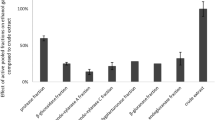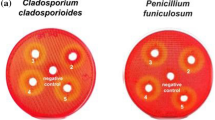Abstract
Agricultural lignocellulosic waste such as corn stover is a potential source of inexpensive, abundant, and renewable biomass for the production of bioethanol. The enzymatic process for the economically viable breakdown of cellulose to ethanol relies on the availability of inexpensive microbial cellulases. Although the cost of cellulase has decreased in recent years, current costs still preclude the production of economically viable bioethanol from lignocellulose. Substantive efforts in this lab are being directed to transgenic production of cellulases in maize in order to boost efficiency both of production of enzymes and degradation of corn stover. We serendipitously observed that the addition of non-transgenic maize seed extracts to cellulose and microbial enzymes potentiated free sugar release by as much as 20-fold. Further, this synergistic effect between cellulase enzymes and extract was seen with a variety of plant species and tissue extracts, but varied in efficiency, and was optimal at low concentrations of cellulases. Although the nature of the synergistic molecule is not known, the use of extracts to potentiate cellulose breakdown provides opportunities for a clearer mechanistic understanding of the degradation process as well as an economical way to improve the efficiency of cellulases to produce more cost-effective bioethanol from agricultural waste.











Similar content being viewed by others
Abbreviations
- CC:
-
Celluclast commercial cellulase enzyme
- CSE:
-
Control seed extract
- GLOX:
-
Glucose oxidase
References
Cho H-T, Cosgrove DJ (2010) Expansins as agents in hormone action. In: Davies PJ (ed) Plant hormones: biosynthesis, signal transduction, action! Kluwer, Dordrecht, pp 262–281
Dai Z, Hooker B, Anderson D, Thomas S (2000) Improved plant-based production of E1 endoglucanase using potato: expression optimization and tissue targeting. Mol Breed 6:277–285
Gusakov A, Salanovich T, Antonov A, Ustinov B, Okunev O, Burlingame R et al (2007) Design of highly efficient cellulase mixtures for enzymatic hydrolysis of cellulose. Biotechnol Bioeng 97:1028–1038
Hettinga W, Junginger H, Dekker S, Hoogwijk M, McAloon A, Hicks K (2009) Understanding the reductions in US corn ethanol production costs: an experience curve approach. Energy Policy 37:190–203
Hood E, Woodard S (2002) Industrial proteins produced from transgenic plants. In: Hood E, Howard J (eds) Plants as factories for protein production. Kluwer Academic Publishers, The Netherlands, pp 119–135
Hood E, Horn M, Howard J (2003) Production and application of proteins from transgenic plants. In: Vasil IK (ed) Plant Biotechnology 2002 and Beyond. Kluwer Academic Publishers, The Netherlands, pp 377–382
Hood E, Love R, Lane J, Bray J, Clough R, Pappu K et al (2007) Subcellular targeting is a key condition for high-level accumulation of cellulase protein in transgenic maize seed. Plant biotechnology journal 5:709–719
Howard JA, Hood EE (2005) Bioindustrial and biopharmaceutical products produced in plants. Adv Agron 85:91–124
Howard J, Nikolov Z, Hood E (2011) Enzyme production systems for biomass conversion. In: Hood E, Nelso P, Powell R (eds) Plant biomass conversion. Wiley-Blackwell publishers, Hoboken, pp 219–246
Humbird D, Aden A (2008) Biochemical production of ethanol from corn stover: 2008 State of Technology model, Technical Report NREL/TP-510-43205. National Renewable Energy Laboratory (NREL), Golden, CO.
Jimenez-Flores R, Fake G, Carroll J, Hood E, Howard J (2010) A novel method for evaluating the release of fermentable sugars from cellulosic biomass. Enzym Microb Technol 47:206–211
Johansson DJA, Azar C (2006) A scenario based analysis of land competition between food and bioenergy production in the US. Clim Chang 82:267–291
Jørgensen H, Kristensen J, Felby C (2007) Enzymatic conversion of lignocellulose into fermentable sugars: challenges and opportunities. Biofuels Bioprod Biorefin 1:119–134
Khan S, Rajan V, Howard J (2011) Plant molecular pharming: industrial enzymes. In: Myers RA (ed) Encyclopedia of Sustainability Science and Technology. Springer, New York
Kim S, Dale BE (2005) Life cycle assessment of various cropping systems utilized for producing biofuels: bioethanol and biodiesel. Biomass and Bioenergy 29:426–439
Ransom C, Balan V, Biswas G, Dale B, Crockett E, Sticklen M (2007) Heterologous Acidothermus cellulolyticus 1,4-beta-endoglucanase E1 produced within the corn biomass converts corn stover into glucose. Appl Biochem Biotechnol 137–140:207–219
Rubin EM (2008) Genomics of cellulosic biofuels. Nature 454:841–845
Sticklen MB (2008) Plant genetic engineering for biofuel production: towards affordable cellulosic ethanol. Nat Rev Genet 9:433–443
Taherzadeh M, Karimi K (2007) Enzyme-based hydrolysis processes for ethanol from lignocellulosic materials: a review. BioResources 2:707–738
Woodard S, Mayor J, Bailey M, Barker D, Love R, Lane J (2003) Maize (Zea mays)-derived bovine trypsin: characterization of the first large-scale, commercial protein product from transgenic plants. Biotechnol Appl Biochem 38:123–130
Ziegelhoffer T, Will J, Austin-Phillips S (1999) Expression of bacterial cellulase genes in transgenic alfalfa (Medicago sativa L.), potato (Solanum tuberosum L.) and tobacco (Nicotiana tabacum L.). Molecular Breeding: New Strategies in Plant Improvement 5:309–318
Ziegler M, Thomas S, Danna K (2000) Accumulation of a thermostable endo-1, 4-β-d-glucanase in the apoplast of Arabidopsis thaliana leaves. Mol Breed 6:37–46
Acknowledgments
This work was supported by a grant from the US Dept. of Energy (DE FG36 GO88025) with cost share from the Wal-Mart Foundation, the Walton Family Foundation, and Arkansas State University. We would also like to thank Nassim Naderi for her expert technical assistance and Dr. Vidya Rajan for help with preparation of the manuscript. JC was sponsored by the Department of the Navy, Office of Naval Research, under Award # N00014-08-1-1209.
Author information
Authors and Affiliations
Corresponding author
Rights and permissions
About this article
Cite this article
Hayden, C., Fake, G., Carroll, J. et al. Synergistic Activity of Plant Extracts with Microbial Cellulases for the Release of Free Sugars. Bioenerg. Res. 5, 398–406 (2012). https://doi.org/10.1007/s12155-011-9149-z
Published:
Issue Date:
DOI: https://doi.org/10.1007/s12155-011-9149-z




